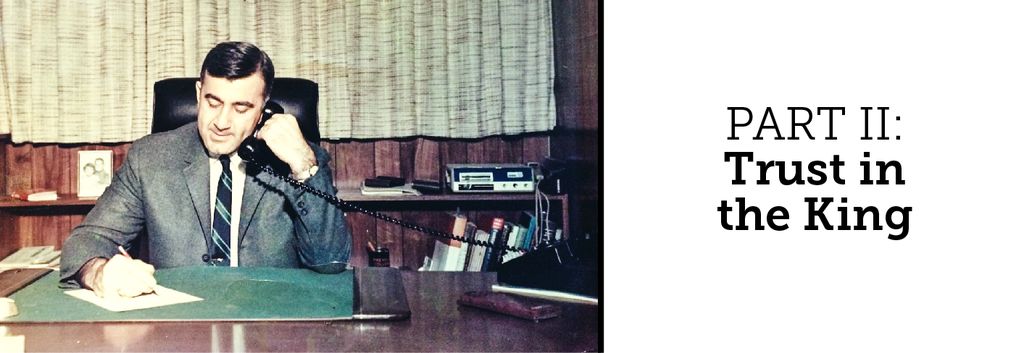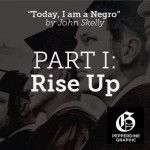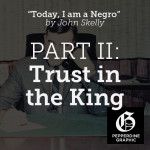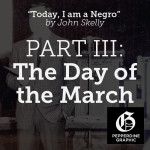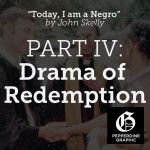Continue reading along with John:
I arrived home around 6 a.m. when my memoir takes on its other deeper meaning. Gracing our dining table was an open Oxnard-Press Courier newspaper dated, Thursday, March 25, 1965, and staring at my tired eyes was the headline, “Today I am a Negro, declares Port Pastor in rights March.”
I was overwhelmed because I was home with my 3-year-old son, Tim, my 18-month-old daughter, Joanie, and my wife, Una. I was safe and we were all safe.
Quietly going to their rooms, I then sat in my favorite leather chair drinking a glass of milk while reading the news headline again about Rev. Washington and me.
Thumbing through the newspaper, I noticed a small article about a civil rights activist Viola Liuzzo, who, while shuttling marchers back to the Montgomery Airport was shot by members of the Ku Klux Klan. She was 39 years old, a housewife and mother of five children. Her name is inscribed on the Civil Rights Memorial in Montgomery, Alabama.
In my favorite chair, I felt safe, but uncomfortable and agitated at the continued violence that I had missed going to the airport.
On Friday morning, one day after my one day experience participating in the Civil Voting Rights March that had changed the nation and my life, I thought it was over for me and I had made my mark. I was home, safe and secure.
But I soon learned that it was not over for me. My involvement, the newspaper article and my new notoriety came with a price.
On Sunday morning, March 28, 1965, my sermon topic was “Alabama Report.” My text, Acts 17:26: “God has made of one blood all the nations of the earth.” I quoted Dr. King who described the March as “a shining moment in the conscience of man.” I shared my experience walking arm and hand with an aging black lady who left the front steps of her humble home and joined us in the march. We hummed, “We shall overcome, we will walk hand in hand someday.” That “someday” came for me. It happened. It was like the bright light of Easter. I shared with my congregation that we were being made alive through this resurrection experience.
I was still on a high as I greeted my church members at the exit steps of our Port Hueneme Chapel. Most of the members of this Seabee Navy town were courteous and some were supportive. However, one of my closest friends hesitated to shake my extended hand perhaps thinking since I said, “Today I am a Negro,” that I was extending a black hand that he could not touch. As my member pulled back his hand, I began to see what price I was to pay for my inspired identification with Negroes on that historic day.
I was so engrossed in my ministry with the troubled youth of our community, preparing sermons, serving on the Ventura Grand Jury, pastoral calling, funerals, weddings, growing a congregation, that I had no idea that my community had negative opinions about my involvement in race relations. They probably thought, “You are our white pastor and you should not be involved with Martin Luther King Jr. You belong to us.”
During the week of March 29, 1965, I learned that there were rumored divisions between white leaders in our community and the black community in the depressed area called Colonia, where my friend, Rev. Washington served as a pastor.
It was my turn to make a presentation to my Rotary Club on Thursday, one week after the last day of the Selma March. I had not prepared a program yet. My slides from the Selma March would be ready by Wednesday. So I thought, “Why not do a presentation on the march to Montgomery and tell of my experience and show slides?” The Port Hueneme Rotary Club membership included the superintendent of the schools, physicians, the chief of police, city mayor, city business manager, commander of our seabee base, school principals and everyone who was a community leader.
Also, a member of the club was Irving Kosowitz, who owned the salvage yard where he kept illegally parked cars and the junk that he hauled away for us.
Irving was a good man. I enjoyed visiting with him on occasion in his junk shack. He shared with me some difficulty he had with his 12-year-old son, and he appreciated my counsel.
I had no idea about what Irving’s background was until my program day on that Thursday at Rotary. I was the chaplain of our Rotary Club. My best friend Al Jalaty, the Chief of Police, paid my dues. Each week I gave the invocation and closing prayer.
Now, armed with my 35mm developed slides in my brand new carousel projector, I showed my experiences, making editorial comments along the way on the road to the state capitol in Montgomery.
The slides showed the gathering at St. Jude’s Center, several actors, some black children at play, my travel companion, Rev. Washington, the throngs of nuns, priests, rabbis, ministers, white people and the thousands of black people who courageously joined in the march.
The scene at the steps facing the Montgomery Capital was impressive. There was a somber note of victory.
What I was showing was evidently threatening some of my Rotary Club colleagues. Their status quo was being disrupted by their young preacher who just one year before, they awarded him “The 1964 Young Man of the Year Award” for his exceptional work with the troubled youth of their community.
To my surprise, following my slide presentation, fellow club members attacked me with barbed questions. The leaders of our fair society in Port Hueneme kept after me. “John, why did you do this?” “Martin Luther King is a known communist!” “Why did you say you were a Negro?” They went on and on. I explained to them that it was my Christian motivation for justice, and that I fought against the tyranny of communism in the Korean War in 1951 and 1952. I had a compulsion — an obligation as a Christian and as a citizen of the USA — to at least march FOR FREEDOM, JUSTICE AND THE VOTING RIGHTS OF ALL Americans.
More barbs were coming at me when my friend, the Chief of Police, Al Jalaty said, “Leave him alone. We need him.” The barbs continued when the most dramatic moment in my young pastoral career happened!
A new twist appeared as an accident — an epiphany! What emerged was an old story of a special history of a people dispersed, held in bondage, and, brutalized in holocausts. The Man who now provided the drama of redemption, of deliverance, was sitting at the end of the dining table.
It was Irving Kosowitz! He stood up, red faced, and with a pitched voice said, “I am a Polish Jew and see what Hitler did to me and my people.” With his massive, worn-out hands and puffed up knuckles, he unbuttoned his clean, white shirt and ripped it off his massive chest. We were all shocked to see tattooed on his heaving chest, the Star of David, JUDEN, and a concentration camp number!
Irving, the Polish Jew, stood up for me, delivered me, a Christian pastor, and said, “Do not silence this young man. Do not be like Hitler. Let him speak!”
The meeting was over. I gave a benediction with tears streaming down my face. I embraced my deliverer, Irving Kosowitz. We all went silently to our places of business to carry out our vocations, never to be the same persons again.
Soon after, the African Methodist Episcopal Church of Oxnard awarded me their Distinguished Citizen Award for my civil rights leadership. Several churches and my Presbytery invited me to tell my story. I was honored and recognized for my participation in the historic march of Selma.
Selma to Montgomery was a new beginning of an endless road. History has shown us that we still have a long road to walk. Fifty years later, the nation and the world is stirring from Ferguson, Missouri, to Mosul, Iraq.
Selma, with all that it was and is for America and the world, is for me an indelible memory of America’s deliverer, Martin Luther King, and my surprise deliverer, Irving Kosowitz. Both Martin and Irving stood up for our right to declare the wonderful riches of God’s love and justice for all.
Let us continue to press on with the inspiring words of Martin Luther King, “If you can’t fly then run, if you can’t run then walk, if you can’t walk then crawl, but whatever you do, you have to keep moving forward.”
So Be It.
Rev. Dr. John Skelly
March 1, 2015
__________
All parts:
Click here for John’s story — 50 Years Since Selma: The Dream Marches On

